This article is brought to you by Gamer Sensei. Learn from the best. Check out Gamer Sensei for your own personal League of Legends coach!
Thousands of fans filled the Staples Center in downtown Los Angeles. Before them was a brightly lit stage, but the night’s action would not happen on the floor. Instead, eyes were directed to enormous video boards that hung from the rafters above. Enraptured fans watched and cheered as the best players in the world duked it out in a fantasy video game environment. The event? The 2016 World Championship. The game? League of Legends.

League of Legends, published by Riot Games, is the most popular game in the world. As of last year, the game claims over 100 million monthly active users. Having conquered the world of esports, League’s next step is to become more mainstream. So what are you waiting for? Read this beginner’s guide and let’s play some League!
What is League?

League of Legends is a multi-player online battle arena (MOBA) computer game. The genre was popularized by the Defense of the Ancients (DotA) mod for the popular real-time strategy game Warcraft 3. Like a strategy game, the camera angle is top-down, allowing players (called summoners) to see their own characters in a third-person view. Outside of a brief tutorial, there is no single-player or campaign mode. Hence the term MOBA. The game is free to download from the game’s website. Because it’s free and can also be played on relatively low system specifications, nearly anyone can download the game client and play. The client is simple and relatively straightforward. The homepage has some Riot-produced content. A “Play” button at the top places players into games. There are links in the upper right to view a player’s profile and visit the store.

The store is where champions, skins, and other things can be purchased (more on those later). Items are purchased with Influence Points (IP, earned through playing the game) or Riot Points (RP, bought from Riot). Certain non-essential items are only available via RP; this is how Riot Games makes money. So download the client, press Play, and let’s get into it!
Game modes
Before starting a game, make sure you have a block of time where you can devote your attention to the game. Most of the game modes pair you with live teammates and opponents, so being present for the entire duration of the game is important. In fact, players can be punished for going away from keyboard (AFK) during a match. The first choice players will have to make is what opponents to face. Beginners will have the option to play against the computer in the Tutorial mode or Co-op vs. AI games to get acclimated. These modes put you against scripted computer-controlled enemies. Once you gain a basic understanding of how the game works, the player vs player (PvP) mode is unlocked. These are live games against real players that will test your skill and knowledge.
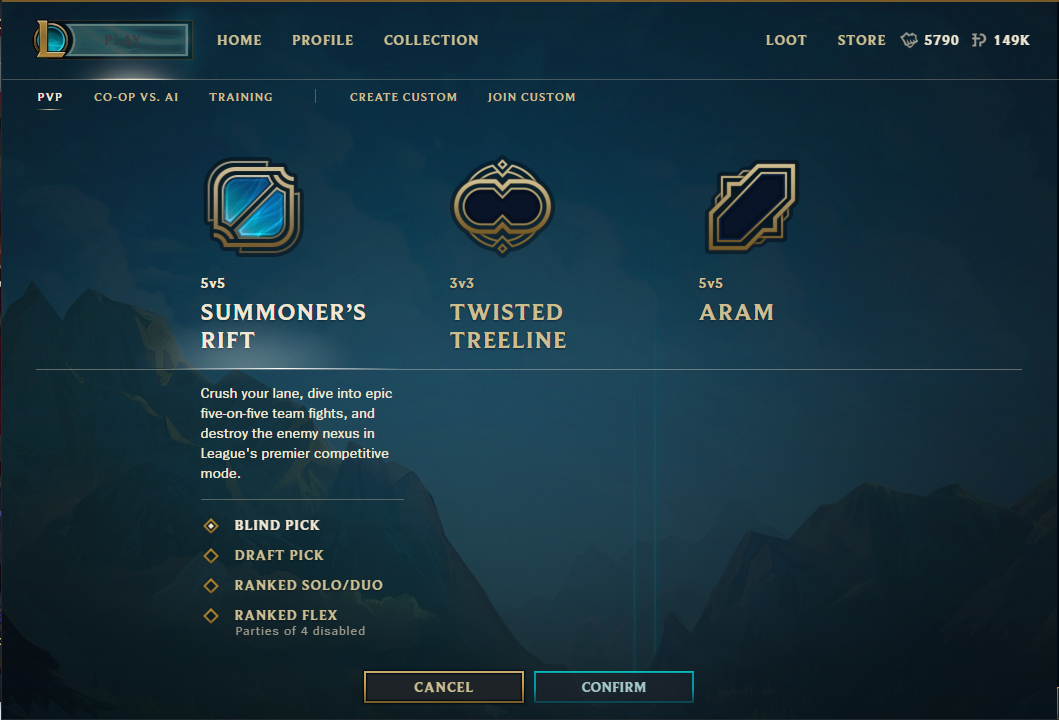
Once players reach a certain level of experience, they can play ranked games. All games run on a matchmaking system where players are paired with others of a similar experience level. Ranked games take that to another level by providing tangible feedback on performance by adding/subtracting points for victories/defeats. As a players accumulate points, they ascend through a tiered ranking system. After selecting the opponent, players choose which game mode to play. Classic is the mode that most players and fans are familiar with. ARAM is a simplified version of the Classic, played on a smaller map and with random champions. There are also rotating game modes; think of these as creative just-for-fun modes. Finally, players will select which map they play on. The most popular game mode is the Classic mode on the 5v5 map, Summoner’s Rift.
The Rift
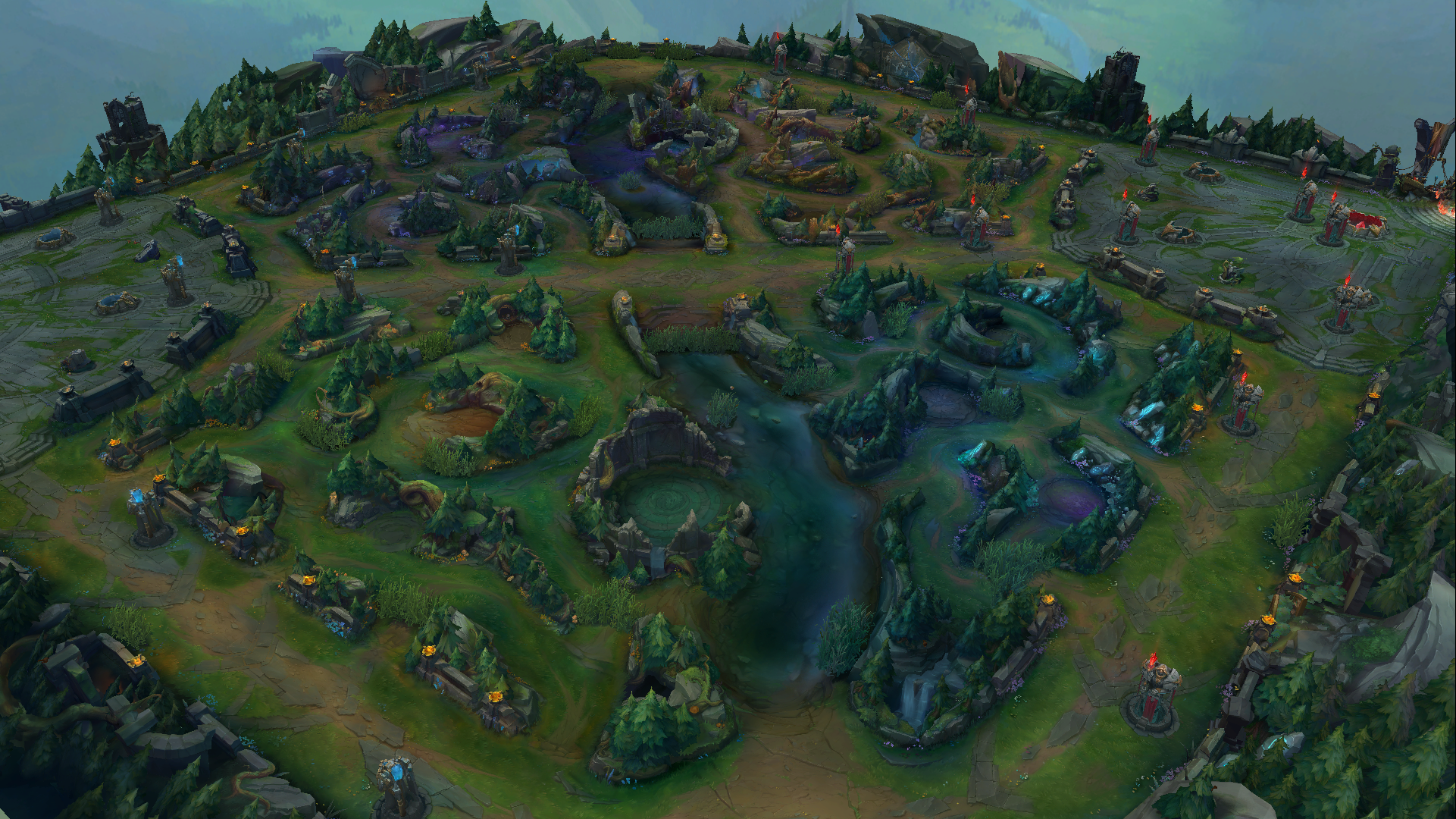
Summoner’s Rift is a fantasy setting that pits two opposing teams of five. Players start with their team in their base (nexus), which is in either the upper right corner (red side) or the lower left (blue side). The object of the game is simple: Work with your team to push to the enemy nexus and destroy it. There are three paths, known as lanes, that connect the two bases. Along each lane and surrounding the bases are a series of defensive fortifications, called turrets. Destroy these turrets to get a shot at the enemy nexus. Around the lanes is a maze called the Jungle inhabited by neutral monsters. Control the jungle, and you control how teams move around the map. Vision works similar to a strategy game: Players share vision with their teammates and other allied units. Small items, called wards, can also be placed in certain locations to provide vision. Outside of these areas, the map is shrouded in the fog of war. Players should be wary of traveling to areas where they don’t have vision. Let’s take a look at the champions you’ll use to dominate the Rift.
Champions
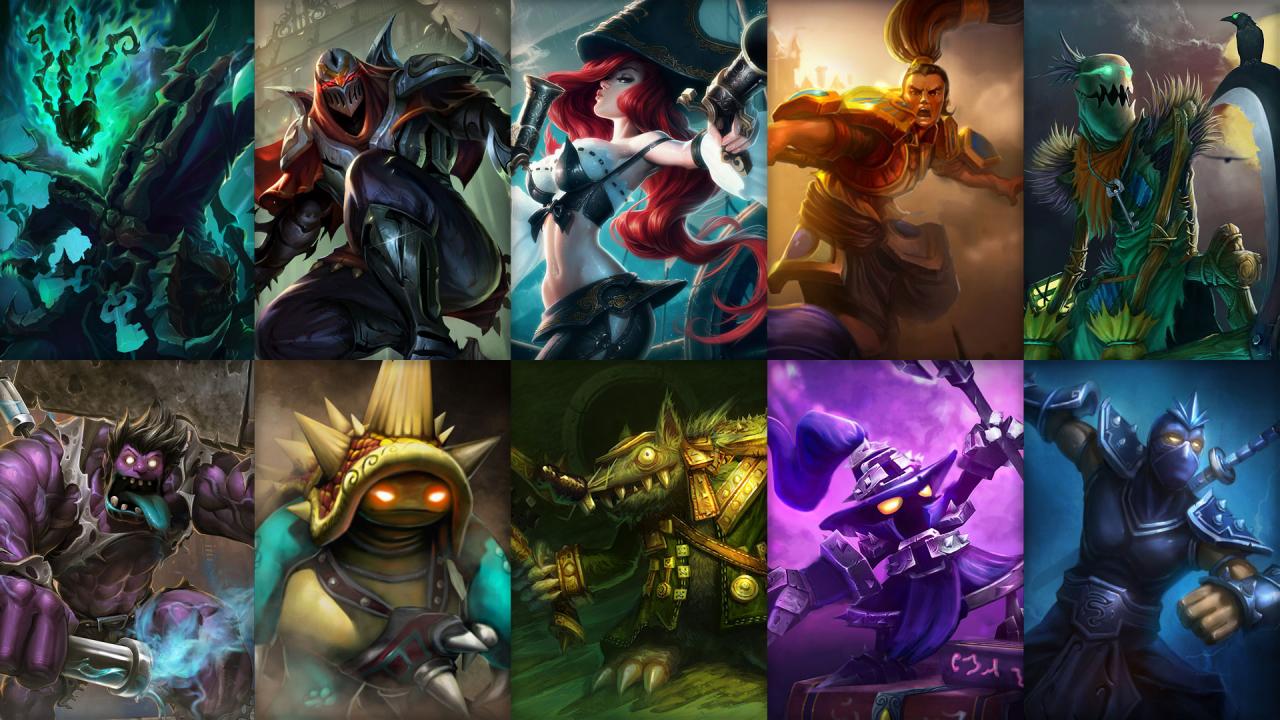
At the beginning of each game, players from both teams select their champions. League has over 100 champions, one of the most diverse pools of any game. There are marksmen who attack from a distance, tanks that soak up damage, mages that use powerful spells to lock down enemies, and assassins that can strike and kill with ruthless efficiency. Picking a champion is like picking a position on a football team. Each champion has strengths and weaknesses that make it more suitable for a particular place on the map. In addition, champions have varying level of synergy with other champions. Currently, the most successful champions are:
- Top lane: Jayce, a punishing lane champion with both melee and ranged attacks
- Jungle: Hecarim, a speedy man/horse hybrid that can zoom around the map
- Mid lane: Corki, a little old man in a fighter plane that uses rockets and a minigun to attack from range
- Bot lane: Jhin, a deadly sniper who can kill opponents from long distance
- Support: Zyra, a powerful mage who can trap enemies for her teammates to destroy
Players control champions with a combination of the mouse and keyboard. The mouse controls movement: right-click to move and attack, left-click to select. The keyboard controls champion abilities; most things beside movement require a keyboard input. Each champion has access to five unique abilities: Four actives mapped to the Q-W-E-R keys and a passive that doesn’t require any input. Abilities are extremely varied: Some can bring back the dead while others do crazy amounts of damage. Clever usage of a champion’s abilities, movements, and basic attacks are known as mechanics. Each new player account gets temporary access to a small pool of champions to get familiar with the game. After gaining a few levels, players will instead get access to a weekly rotating cast of 10 free champions. If you find a champion you like, you’ll have to unlock it from the store in order to maintain access outside of the free rotation. The best players will be proficient on many champions. For beginners, however, it’s often helpful to stick to a small number of similar champions to get familiar with the game.
Laning
Along with selecting a champion, you’ll need to work with your team to decide which lane to play in. New players will be using a blind pick system in which players decide with their teammates which role they will play. As you progress, a draft pick option will become available to allow you to queue for a specific role (and see what champions the enemy team is drafting).
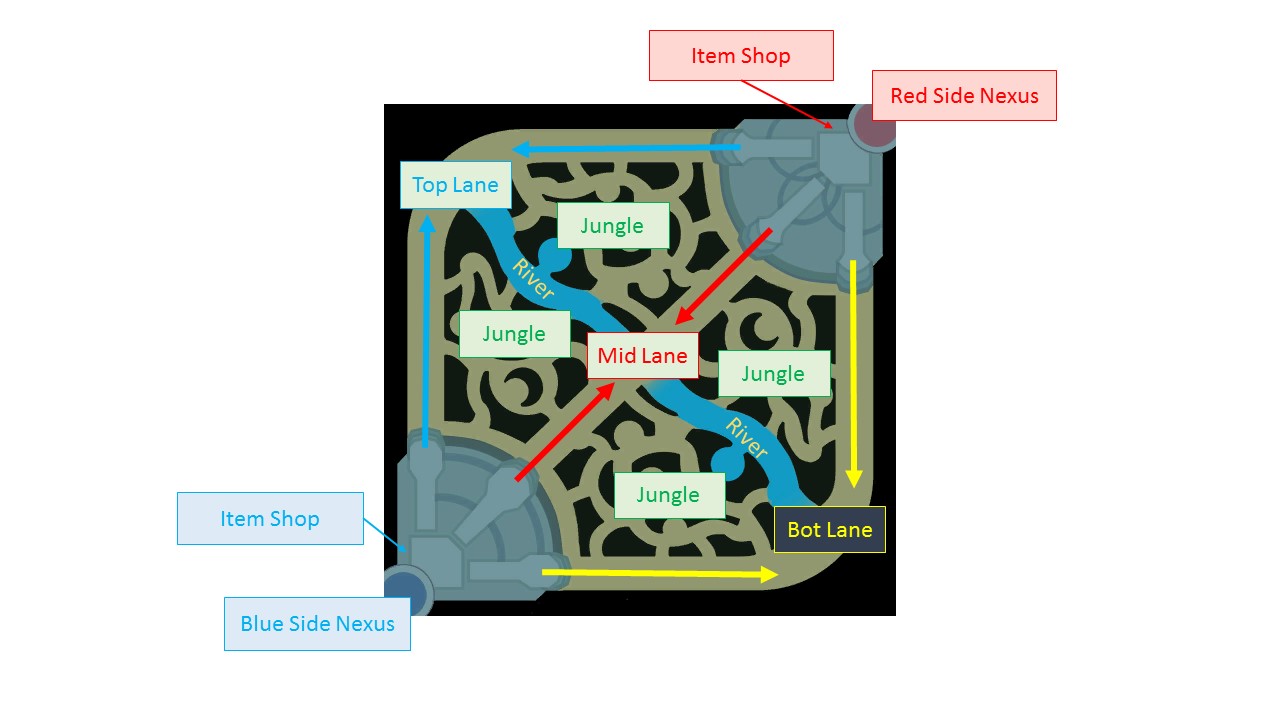
Most teams will assign a single player to the top and mid lanes, two players to the bot lane (a damage dealer and a support), and one player to the jungle. But when you’re just starting out, ignore the jungle and just head to a lane. The jungle’s powerful monsters take a while to get used to. It’s a good idea to match League’s AI, which typically assigns two champions to the top and bot lanes and one to the mid lane. The first 10-20 minutes of each game is the lane phase, when players generally stay in their lanes. The goal is to push your opponents away and destroy their turrets. To do that, you’ll need help from minions (or creeps), weak computer-controlled units that spawn every 30 seconds at each nexus. Each spawn creates three waves of 6-7 minions each; each wave proceeds single file down each of the lanes. Minions cannot be controlled and will attack the first enemy they see. Minions serve two main purposes. First, dealing the killing blow on an enemy minion (also known as last hitting) gives gold. The first skill players will want to learn is how to consistently last hit minions. Remember, the minions will attack each other, so you have to understand your damage potential and sync your attacks with your allies.
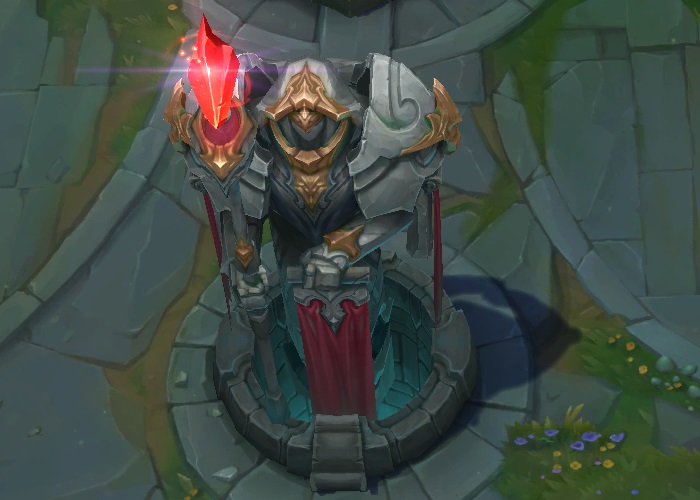
The second thing minions do is help destroy turrets. Turrets, in addition to having a lot of armor and health, shoot powerful energy bursts at enemies in range. Even strong champions can be reduced to ashes by walking too close to a turret. But turrets are designed to target minions before champions. Escorting your minions within a turret’s range (known as shoving) allows you to safely attack the turret itself. Be careful not to attack enemy champions within their turret’s range—turrets ignore minions and start targeting champions if the champions are fighting each other. To start, work on last-hitting, or framing, minions with auto attacks by right-clicking on the minion just before it’s about to die. Laning can be extremely complex, and the best players know how to manipulate minion behavior expertly while last hitting and attacking enemy champions. Strong laning skills are revered in the League community. The best laners know how to draw attention without dying, freeing their teammates to play more aggressively. But as fun as laning can be, the phase generally ends when one or more turrets are destroyed. That opens the map for some real fun: Team fights.
Fighting

Fighting is what most League players are playing for. After getting some items and levels from laning, team members will seek to group together and take turrets and other objectives. Often, the team that groups faster and more effectively can tilt the game heavily in their favor. Each champion has strengths and weaknesses, and when diverse champions are grouped, the team can amplify its strengths and mitigate weaknesses. Effective teamfighting requires good communication: Players need to know where they’re going and what their objective is. It also requires good positioning: Damage-soaking tanks should lead the charge while squishier targets should primarily position to stay alive. Damage dealers are no good to their teams when dead. As a beginner, you’ll want to keep a close eye on the minimap, located at the bottom right of the screen. Good players check the map constantly; when they notice that their team is moving in for a fight, they react quickly to join. Once you’ve joined a fight, the first thing to remember is: Don’t die. Dying gives the enemy team gold and eliminates your champion from the fight for a period of time. Some champions are meant to dive right into the middle of a fight, but you’ll want to be careful with your health and mana resources. Try to stay relatively safe while focusing damage on one enemy at a time. Fights can get chaotic with champion abilities flying everywhere, but try to move with your teammates. Fighting is a lot of fun but can be very complicated!
Items and Abilities
Before diving into fights, it’s important to make your champion stronger. There are two ways to do that: Gold and experience. As introduced in the laning section, gold is earned by last-hitting minions. Killing an enemy champion or structure also grants a bonus gold to those involved (and in some cases, gold for the entire team). Gold is spent at the item shop, which is located right next to the allied nexus. The item shop dialogue box can be opened anytime by clicking on the shop itself or hitting the keyboard shortcut (P). But players can only interact with the shop while in base—unless you’re playing Ornn. To get back to base, hit (B) to recall. Recalling will also allow you to heal and restore mana for the next fight.

The item dialogue box displays recommended items for each champion as well as all items available. While the recommendations are useful, it’s helpful to do some research on champions that you play frequently to learn what type of items are popular—and why. Items can help players deal more damage, reduce the cooldowns on their abilities, and heal their teammates. Experience is earned by standing near dying enemies. As a champions gain experience they increase in levels, from 1 to 18. Each level unlocks an ability point which is used to upgrade or gain access to an ability. Like items, it’s helpful to research each champion’s abilities to understand the optimal allocation of ability points. Each player starts the game with 500 gold and one ability point. The first thing you’ll want to do is spend the gold at the shop and level up a skill before you leave base. Players should also avoid accruing large gold balances before recalling and buying items. Gold doesn’t do you any good in your pocket! In addition to abilities and items, summoners have a few other tools to develop their champions.
Runes and summoner spells
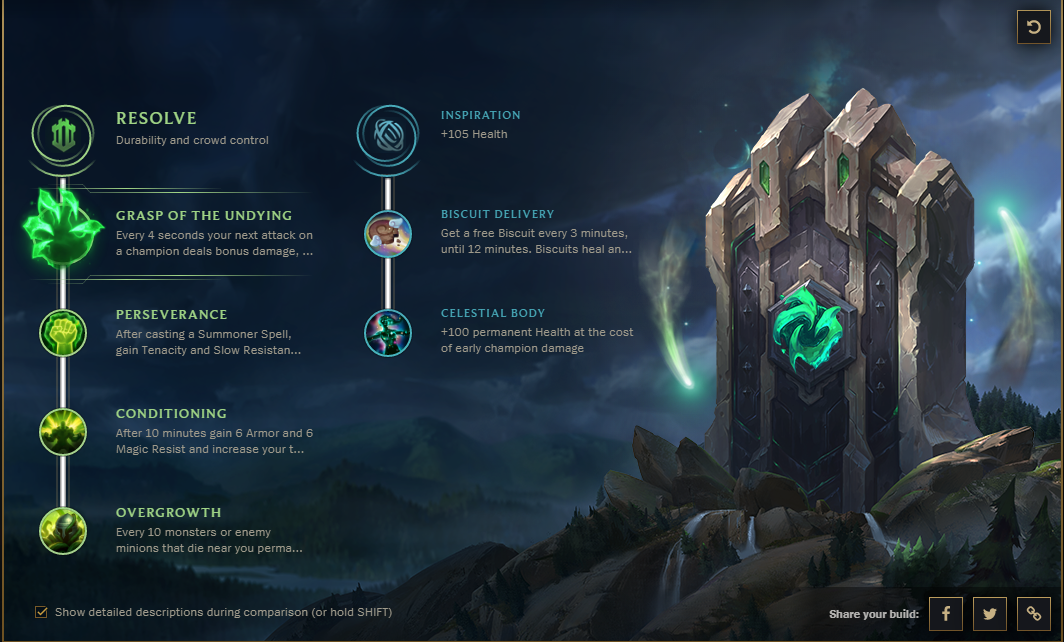
Just as champions increase in level throughout the game, player accounts gain levels as more games are played. Along the way, players gain access to other options that enhance the experience, including runes and summoner spells. Runes are a way to customize champions to a player’s preferred style. They include basic things like increased situational damage all the way to wonky things like the ability to steal consumable items and gold from enemy champions. There are currently five different rune trees:
- Precision: Runes that give speed and damage based on a player’s skill and mechanics.
- Domination: Pure damage for those that want to go all-in.
- Sorcery: This path is for mages. It enhances their abilities and ability to sling spells.
- Resolve: Tanky ruins that benefit high-health champions.
- Inspiration: Runes that literally break the rules of the game.
A new rune system, introduced before season eight, makes all runes free, though players will still have to pay for additional rune pages. All player accounts start with basic runes, and as they level up, additional runes are made available. Before stepping into a match, players can select which one of their rune pages to use and even edit the rune pages themselves. Finally, each player can choose two summoner spells to take into game in addition to their unique champion abilities. Summoner spells are extremely powerful spells that can teleport a player across the map, provide a burst of healing, or break crowd control. Like other abilities, they’re activated with a button. One key difference, however, is that summoner spells incur large cooldowns—so use them with care. The options to choose summoner spells are in the middle of bottom of the pregame champion select screen. Player accounts start with a few basic summoner spells and gain more as they level up. Beginners will want Ghost—the ability to go fast—and Heal—an spell that can save someone’s life. Once Flash becomes available, most players will want to swap Ghost for this spell that teleports their champion a short distance instantly. It’s great to get out of tight situations or initiate a fight. It sounds pretty complicated. But our best advice for beginning players is to just play and explore and worry about these things once you have a feel for the game.
Professional League

League also boasts one of the most vibrant professional scenes in esports. The most recent World Championship, which took place last October, drew sellout crowds at historic venues like Madison Square Garden and Staples Center. Fans interested in seeing League played at its highest level have many ways to watch. There is a professional circuit in almost every region. In North America and Europe, Riot runs the League Championship Series. There are also leagues running in South Korea, China, Taiwan, and even among Oceanic countries. Fans can get the basic information for these leagues at Riot’s esports website. Matches can be viewed for free on various Twitch channels as well as YouTube.
Resources
This is a lot of information for new players. After reading this, we feel like the best way to get into League is to play some games and watch some professional broadcasts. To that end, we’ve included some helpful links below for you to navigate at your leisure as you begin to explore the world of League of Legends.
- Mobafire and Lolking – Sites with player champion guides and other helpful info
- Champion.gg – Gives stats on all League champions played in ranked games; which champions are doing well and what item builds are most popular
- Probuilds – See how the pros play their champions. This site shows statistics, items, masteries, and other information from games professional players play. Note that some pros may be trying very unique strategies that should not be copied by everyone!
- OP.gg – The go-to site for your personal stats. Input your summoner name to find a detailed match history and other personal stats
- EsportsWikis – A one-stop location for all information on competitive League of Legends
We hope you’ve enjoyed our guide to League of Legends. See you on the Rift! All photos and images via Riot Games


